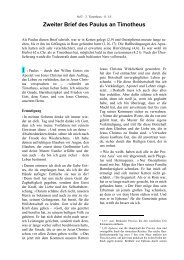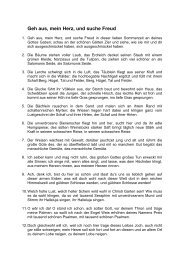You also want an ePaper? Increase the reach of your titles
YUMPU automatically turns print PDFs into web optimized ePapers that Google loves.
The cornea’s main task is to protect the delicate<br />
components of the eye against damage by foreign<br />
bodies. The iris is located between the cornea and<br />
the lens, and its function is to control the amount<br />
of incident light, in the same way as the diaphragm<br />
of a camera. The lens focuses the incoming<br />
light rays on to the retina (Latin: rete = net),<br />
where the actual process of perception begins.<br />
The photo-receptors (the rods and cones) convert<br />
the incident ’optical signals’ into chemical (and<br />
subsequently into electrical) signals. These electrical<br />
signals then travel to the brain along the<br />
optic nerve. There are no photo-receptor cells at<br />
the point where the optic nerve leaves the retina,<br />
and this is known as the “blind spot”. Another<br />
important feature of the retina is the so-called<br />
“yellow spot” (the macula lutea). In the middle of<br />
this is the fovea centralis, the point where visual<br />
acuity is at a maximum. There are no rods in this<br />
position, only cones, which are connected in a<br />
special way to the relevant nerve cells. When you<br />
focus your attention on a certain object, your<br />
head and eyes automatically move in such a way<br />
as to let its image fall on the fovea for greatest<br />
sharpness.<br />
The retina: The back of the eye can be observed<br />
through the pupil using an ophthalmoscope. The<br />
retina, with the blood vessels supplying its inner<br />
layers, can be seen, as well as the blind spot and<br />
the yellow spot.<br />
The retina plays a key role in visual perception.<br />
This thin (only 0.2 mm) layer of nerve tissue lines<br />
Canal of Schlemm<br />
Reflection of the covering<br />
layer (conjunctiva) from<br />
the front of the eye to the<br />
inside of the eyelid<br />
The ora serrata:<br />
Posterior to this<br />
point, the retina<br />
is light-sensitive<br />
Pupillary opening<br />
Cornea<br />
Anterior chamber<br />
Iris<br />
Posterior chamber with<br />
lens filaments<br />
Ciliary muscle<br />
Lens<br />
Choroid<br />
Retina<br />
The outer or ‘hard‘ layer<br />
of the brain’s covering<br />
membranes (Dura mater)<br />
Optic nerve<br />
Blind spot (optic papilla)<br />
External<br />
eye (lateral<br />
rectus) muscle<br />
Sclera<br />
Vitreous body<br />
Yellow spot (macula lutea,<br />
containing the central fovea)<br />
Visual axis<br />
14<br />
Transverse view of the right human eye<br />
(after Faller/Schünke, Der Körper des Menschen,<br />
Thieme-Verlag)
















